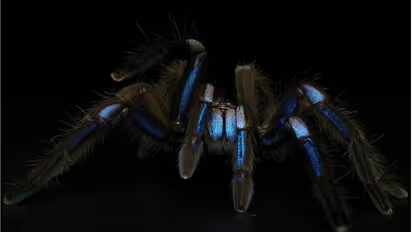Fascinating! Discovery of rare electric blue tarantula in Thailand highlights nature's vibrant beauty - WATCH

Synopsis
The article discusses the discovery of an electric blue Tarantula species in Thailand, its unique structural coloration, and the significance of taxonomy in preserving species.
A striking discovery has been made in the lush forests of Thailand – an electric blue Tarantula species. Thai researchers, in collaboration with YouTuber JoCho Sippawat, stumbled upon this impressive arachnid during an expedition in the Phang-Nga province of southern Thailand. Their mission aimed to study the diversity and distribution of tarantulas in the country. The newfound spider has been officially named Chilobrachys natanicharum and was spotted in a mangrove forest. The details of this remarkable discovery were documented in the research journal ZooKeys, with the publication date set for September 18.
Narin Chomphuphuang, a researcher from Khon Kaen University's Department of Entomology and Plant Pathology, described the find as follows: "We found a new species of tarantula that exhibits a mesmerizing blue-violet hue, reminiscent of electric blue sparks."
Interestingly, this electric blue tarantula had been circulating within the exotic spider trade for some time, commonly referred to as the Electric Blue Tarantula. Various shops purportedly sold these striking spiders for substantial sums, often reaching hundreds of dollars.
"Blue is one of the rarest colours to appear in nature, which makes blue colouration in animals particularly fascinating," a Thai team led by arachnologist Narin Chomphuphuang of Khon Kaen University told CNN.
"To appear blue, an object needs to absorb very small amounts of energy while reflecting high-energy blue light," which is challenging, he explained.
"These tarantulas inhabit hollow trees, and the difficulty of catching an electric-blue tarantula lies in the need to climb a tree and lure it out of a complex of hollows amid humid and slippery conditions. During our expedition, we walked in the evening and at night during low tide, managing to collect only two of them," he added.
In nature, blue is predominantly found in birds, fish, and certain insects like butterflies. The blue hue of tarantulas, however, does not result from pigment but rather from structural coloration. This intricate process involves nanoscopic structures reflecting light in a manner that creates the shimmering blue and violet hues, as explained by ScienceAlert.
The study also highlighted the uniqueness of blue coloration in tarantulas. This structural coloration evolved independently at least eight times, setting tarantulas apart from birds and insects. Tarantulas exhibit less iridescence and maintain highly conserved reflectance within a specific narrow band of wavelengths.
Chomphuphuang emphasized the adaptability of the electric blue tarantula, noting their ability to thrive in both arboreal and terrestrial burrows within evergreen forests. However, in mangrove forests, their habitat is confined to tree hollows due to the influence of tides. He also stressed the importance of taxonomy in research, emphasizing its role in preserving species from extinction and providing valuable information to the public. Understanding the significance of taxonomy, from identifying spiders to vital research efforts, contributes to the protection of these unique creatures.
Check the Breaking News Today and Latest News from across India and around the world. Stay updated with the latest World News and global developments from politics to economy and current affairs. Get in-depth coverage of China News, Europe News, Pakistan News, and South Asia News, along with top headlines from the UK and US. Follow expert analysis, international trends, and breaking updates from around the globe. Download the Asianet News Official App from the Android Play Store and iPhone App Store for accurate and timely news updates anytime, anywhere.